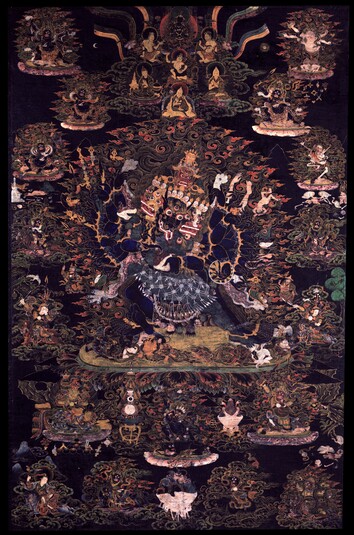
Item: Vajrabhairava (Buddhist Deity)
| Origin Location | Tibet |
|---|---|
| Date Range | 1700 - 1799 |
| Lineages | Gelug and Buddhist |
| Size | 66.04x43.18cm (26x17in) |
| Material | Ground Mineral Pigment, Black Background on Cotton |
| Collection | Rubin Museum of Art |
Classification: Deity
Vajrabhairava (Tibetan: dor je jig je. English: Vajra Terror) with the consort Vajra Vetali surrounded by the main protectors of the Gelugpa School. Vajrabhairava is a meditational deity (ishtadevata) of the Anuttarayoga Classification of Buddhist Tantra. As the supreme meditational deity of the Gelug Tradition Vajrabhairava is also looked upon as the Lord or Master of the various protector deities of the Gelug Tradition. Within the Himalayan and Tibetan art traditions it is common to find the painted composition of Vajrabhairava surrounded by these protector figures.
Vajrabhairava, in the center, is terrifying and wrathful, dark blue in colour with nine faces, thirty-four hands and sixteen legs. The main face is that of a buffalo, with a red face above and the slightly angry face of Manjushri placed on top. The three right faces are yellow, dark blue and red and the three left are black, white and smoky. Each face has three large round eyes, bared white fangs and frightful expressions; dark yellow hair flows upward; adorned with bone ornaments and a necklace of fifty heads. The first pair of hands hold a curved knife and skullcup embracing the consort. The remaining hands hold a variety of objects. Vajra Vetali has one face and two hands, blue in colour with orange hair pressed against the back; holding a skullcup in the left hand. The right legs of Bhairava are bent pressing down on various animals and gods. The left legs are extended straight and press upon various birds and gods; standing above an orange sun disc and multi-coloured lotus completely surrounded by the orange flames of pristine awareness.
At the top center is a Vajradhara, the primordial buddha, with one face and two hands holding a vajra and bell to the heart. Directly below Vajradhara to the right and left are two mahasiddha figures. The siddha on the viewers left holds a fish identifying him as the famous mahasiddha Tilopa. Slightly below that is Tsongkapa depicted as a mahasiddha riding a tiger and holding a sword and skullcup. Below that are three mahasiddha figures, Atisha and Tsongkapa. Below that is a Gelugpa teacher wearing the yellow hat and holding a white lotus in the right hand. The left hand holds a long-life vase in the lap. It is likely that this image is of the 7th Dalai Lama.
Descending at the left side are: Shadbhuja Mahakala with six hands, Panjarnata Mahakala with two hands, Chaturbhuja Mahakala with four hands, Shri Devi with four hands and riding a donkey, a warrior figure riding a horse and Vaishravana riding a lion.
Descending at the right side are: white Sita Shadbhuja Mahakala, Chaturmukha Mahakala with four faces, Shmashana Adhipati, Shri Devi Magzor Gyalmo, King Gesar and Begtse Chen.
At the lower center is the outer Yama Dharmaraja, black, with a buffalo head and two hands, accompanied by the consort Chamundi; both riding a buffalo. Four worldly protectors are depicted along the bottom of the composition.
As a meditational deity Vajrabhairava, also known as Yamantaka by Western scholars, belongs to the Yamari class of tantras and specifically arises from the Vajrabhairava Root Tantra (Tibetan: Jig je tsa gyu) and is classified as method (father) Anuttaryoga Tantra. The practice of Vajrabhairava is common to the three Sarma Schools: Sakya, Kagyu and Gelugpa. There are numerous forms and styles of practice from the very complex with numerous deities to the very concise with a single Heruka form. The main lineages to enter Tibet were those of Jowo Atisha, Rwa Lotsawa, Mal Lotsawa and the like.
This form of Vajrabhairava with the central faces placed three vertically and three faces to each side arranged horizontally is common to the Gelugpa School and true to a visionary experience of Lord Tsongkapa the founder.
Jeff Watt 8-98
Tradition: Gelug Deity Paintings
Painting Type: Black Ground Main Page
Buddhist Deity: Vajrabhairava Main Page
Collection of Rubin Museum of Art (RMA): Main Page
Painting Type: Black Ground (Eastern Tibet, Kham)
Painting: Vajrabhairava (Blackground)
Collection of RMA: Black Ground Masterworks (Curator's Selection)
Buddhist Deity: Vajrabhairava & Gelug Protectors Composition
Collection of RMA: Black Ground Masterworks
Buddhist Deity: Vajrabhairava (Black Ground Masterworks)


